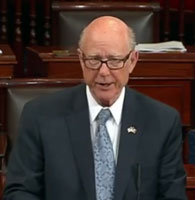The U.S. House yesterday approved the National Bioengineered Food Disclosure Standard by a vote of 309 to 117. The legislation, which preempts individual state laws to require labeling of foods containing genetically engineered ingredients, was passed by the Senate last week and is expected to be signed by President Obama.
 “I have said this is the most important food and agriculture policy debate of the last 20 years,” said Senate Agriculture Committee Chair Pat Roberts (R-KS), who crafted the bill with Ranking Member Debbie Stabenow (D-MI). “I am confident we have put forward a comprehensive solution that considers all aspects of our food production and delivery system while keeping the consumer top of mind.”
“I have said this is the most important food and agriculture policy debate of the last 20 years,” said Senate Agriculture Committee Chair Pat Roberts (R-KS), who crafted the bill with Ranking Member Debbie Stabenow (D-MI). “I am confident we have put forward a comprehensive solution that considers all aspects of our food production and delivery system while keeping the consumer top of mind.”
The American Seed Trade Association (ASTA) President & CEO Andrew LaVigne praised “all the Republicans and Democrats in both the House and Senate who put politics aside and came together to do what’s right for American families and farmers… Thanks to this bill, products produced through this method will not be unfairly stigmatized with mandatory on-pack labels.”
“(W)e now begin the work of putting in place a uniform, national labeling system that will provide balanced, accurate information to consumers,” said American Farm Bureau Federation president Zippy Duvall. “This legislation helps to continue those benefits by avoiding the confusion of differing and potentially misleading labeling standards from state to state.”
Over 1,000 food and agricultural organizations supported passed of the bill, including the National Corn Growers Association, American Soybean Association, National Council of Farmer Cooperatives, and American Feed Industry Association.












